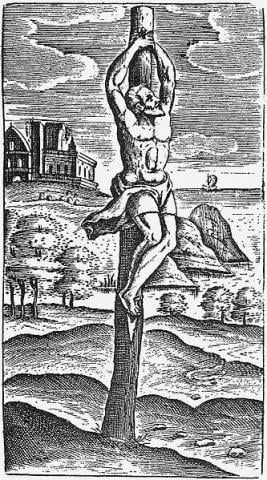Rome used crucifixion as a mean of execution for many centuries. One of the most famous events, involving mass crucifixions, occurred around 71 BC after a slave uprising led by Spartacus.
Contemporary sources tell us that so many men were crucified—about 6,000—that crosses lined the road from Rome to Capua. Appian of Alexandra tells the story (in his Civil Wars):
Spartacus [a gladiator leading a rebellion against Rome], who was waiting for some cavalry that were on their way to him, no longer went into battle with his full force, but conducted many separate harassing operations against his besiegers; he made sudden and repeated sorties against them, set fire to bundles of wood which he had thrown into the ditches, and made their work difficult.
He crucified a Roman prisoner in no-man's land to demonstrate to his own troops the fate awaiting them if they were defeated.
Indeed ... what was "awaiting them," when they were defeated, was crucifixion:
Since there was still a very large number of fugitives from the battle in the mountains, Crassus [the Roman general leading six legions against the rebellious gladiators] proceeded against them.
They formed themselves into four groups and kept up their resistance until there were only 6,000 survivors, who were taken prisoner and crucified all the way along the road from Rome to Capua. (From Appian’s Civil Wars, 1.116-120, translated by John Carter and online, courtesy University of Chicago.)
Because crucifixion was an excruciating way to die, Rome did not impose this type of punishment on its own citizens.
N.P. DePasquale and G.E. Burch published an article, “Death by Crucifixion,” in the American Heart Journal during 1963. In this article, the authors—using medical terms—describe what happened to a person who was executed by means of a Roman-style crucifixion:
...it appears likely that the mechanism of death in crucifixion was suffocation.
The chain of events which ultimately led to suffocation are as follows: With the weight of the body being supported by the sedulum [see below], the arms were pulled upward. This caused the intercostal and pectoral muscles to be stretched.
Furthermore, movement of these muscles was opposed by the weight of the body. With the muscles of respiration thus stretched, the respiratory bellows became relatively fixed.
As dyspnea [shortness of breath] developed and pain in the wrists and arms increased, the victim was forced to raise the body off the sedulum, thereby transferring the weight of the body to the feet. Respirations became easier, but with the weight of the body being exerted on the feet, pain in the feet and legs mounted.
When the pain became unbearable, the victim again slumped down on the sedulum with the weight of the body pulling on the wrists and again stretching the intercostal muscles. Thus, the victim alternated between lifting his body off the sedulum in order to breathe and slumping down on the sedulum to relieve pain in the feet.
Eventually, he became exhausted or lapsed into unconsciousness so that he could no longer lift his body off the sedulum. In this position, with the respiratory muscles essentially paralyzed, the victim suffocated and died. (DePasquale, N. P. and G. E. Burch. 1963. “Death by Crucifixion.” American Heart Journal 66: 434.)
This image, of a crucified individual, is by Justus Lipsius (1547-1606). It is included in De Cruce Libri Tres, published in Antwerp during 1629 (at page 67).
Media Credits
Image online, courtesy Wikimedia Commons.


